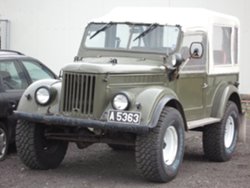
Here are a few interesting facts about the Russian 4x4 named Gaz 69.
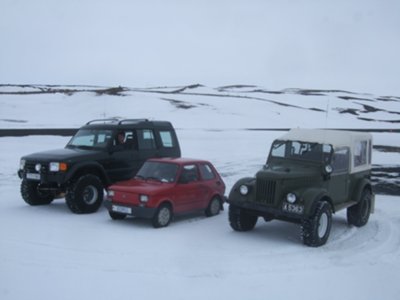
This picture is taken in the beginning of a 4 wheeling tour on snow just north of Gjástykki Maundy Thursday. I drove north on the tiny Fiat and made the tour on a 43 year old Russian 4x4 I use for filming a documentary about the Leirhnjúkur-Gjástykki area (close to lake Mývatn).
Accompanying me was Andri Karlsson on a Land Rover Discovery on 38 inch tires.
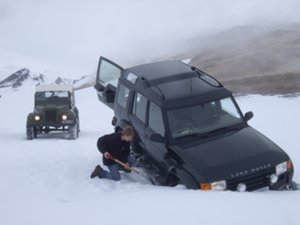
The Russian 4x4 is only 1650 kg, 500 kg. lighter and therefore I have decided to use only 35 inch tires for it. The weight difference shows clearly when Andri's 4x4 fell two times down through the snow shell where the Russian flew over.
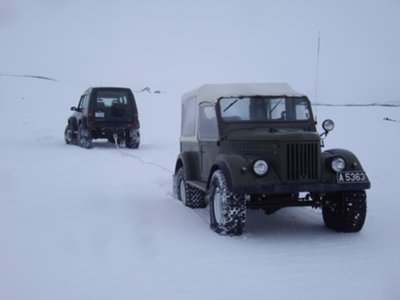
At a later time the Russian was used to pull the Discovery loose but then a shifting lever in the Russian got disconnected so I could only use the rear wheel drive giving Andri the choice to level the game and pull it up.
On with the Russian. - Because of a British importing ban on the Icelandic cod (around 1952) they began importing Russian cars in the mid 50s and when the left wing government ruled in 1956-58 they began importing Prinz Polo chocolate candy bars from Poland.
The symbol of the era therefore became a unique blend of West and East. With Coke and Prinz as well as Rock and Russian 4x4s.
The Gaz 69 was produced from 1954 to 1972. After that the looks were changed, but it still is basically produced as UAZ 3151.
The Gaz 69 was created as a reform on an older Gaz 4x4 that was a direct copy from the Willys military Jeep that the US had sent the Russians during the war, for a total of 5000.
Gaz 69 became a magnificent improvement.
In the Willys Jeep that formed the revolution in Iceland after the war the engine was located behind the front axle and therefore about 15 cm (6 inches) of space behind the front wheel wells got lost and the driver had to sit right back in line with the rear wheel wheel.
The Land Rover was hardly any better and the transfer case in it sat low and the leaf suspension brackets protruded down because the leafs were under the axles.
The Russians made the Gaz 69 wider and could therefore lift the bed and place the engine above the front axle. Consequently the front seats in the Russian 4x4 are 27 centimeters closer to the front than in the Willlys and the center of gravity moves forward and a feet of space is gained. It is valuable to have the center of gravity not too much backward on an off road vehicle.
The driver and passenger in the front in the Gaz 69 sit right between the axles but not by the rear axle. By making the truck 25 cm longer a big internal space was made and cargo space behind the rear seats.
The Russians placed the leaf springs above the axles and the axle housings are slim and clearance is great, 15 centimeters higher than the Willys and Land Rover of the time. The Russian 4x4 therefore was generally more usable off road, particularly in snow.
The biggest advantage is yet still to be named. The springs were by far the softest leaf springs ever to be produced in the world and this made the vehicles movements smooth and the comfort level and off road capability far better.
The competitions gave hard rides. During the first years of off road competitions in Iceland the drivers put Russian leaf springs under the Willys Jeeps!
I find the Gaz 69 to be a very beautiful car and the successor terribly ugly in comparison.
An American 4x4 magazine chose the classic Bronco to be the best off road vehicle of all times compared with the competition. That Bronco was the first western 4x4 of just about equal size as the Gaz 69, with high clearance and the leaf springs above the rear axles.
The Gaz 69 wasn't without flaw. The engines from the early years were terribly bad, lacking power, with poor mileage, dated design and short lasting to boot. The only advantage was that they had so little power that the risk of spinning or breaking axles was hardly existing.
My Gaz 69 has a six cylinder Bronco engine that has enough power to move it forward without much risk of breaking axles. My dream is to install a recent four cylinder Volga engine that is still manufactured.
The last summer it was a delight to enjoy the suspension in the rough highlands north of lake Mývatn filming and snow driving the other day it came out great.

I own the cheapest RV in Iceland, what we call a "Russian cow", a 1985 russian 4x4 bus that was much used here in Iceland as a school bus and contractor truck.
This 4x4 has incredibly big internal space compared with size. It is only 4.36 meters long, similar to VW Golf.
By looking at picture from the Russian army operations in Chechnya and Georgia and at the time in Afghanistan - we can see that the Russian army has used the Russian cow the last decades and even until today.
I am told that with some Russian neighboring countries vehicles of this type provoke bad memories.
But even so, many Icelanders have fond memories about this usable and comfortable touring 4x4 truck that is still so heavy and difficult to drive.
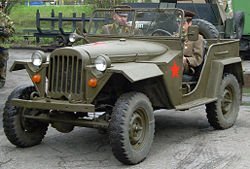
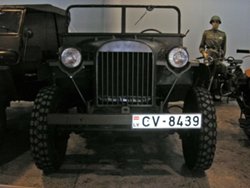
Finally I throw in a few pictures of the Gaz 69 predecessors, Gaz 67 and 64, that were obvious copies of the Willys military Jeep...
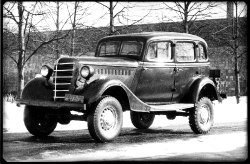
...and a car that some say is the first SUV in the world. Just like modern SUVs of similar size and weight.
Ómar Ragnarsson
Iceland
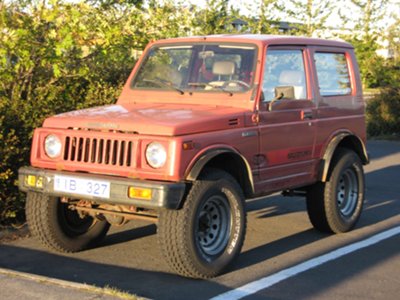
Ómar's 24 year old Suzuki Jimny. The smallest 4x4 in Iceland capable of snow and glacier driving.